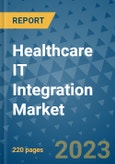The global healthcare industry is experiencing a surge in the adoption of information technology, driven by the need for a single platform to maintain patient and healthcare provider records, enhance medical practice efficiency, and reduce healthcare expenditure. The COVID-19 pandemic further accelerated the urgency to integrate patient data into healthcare systems, leading to a surge in demand for well-connected healthcare technologies and electronic health records (EHRs). Government policies, funding programs, and strategic initiatives have also contributed to the sophistication of the healthcare IT integration market.
Rising Geriatric Population and Investments Drive Demand for Healthcare IT Integration Solutions
Over the forecast period, the demand for healthcare IT integration solutions is projected to escalate due to the increasing elderly population seeking complex care. With growing investments in the healthcare IT sector and the need for integrated solutions with comprehensive databases, high-quality patient care is expected to drive growth in the healthcare IT integration market.
Exponential Expansion of Electronic Health Records (EHRs) and Healthcare IT Solutions
Robust integration and real-time availability of patient data are crucial for healthcare professionals to deliver quality care and make informed decisions. The use of IT in healthcare streamlines processes, reduces repetitive tasks, and ensures data availability across the entire ecosystem, including healthcare systems, hospitals, pharmacies, and medical insurance companies. Government initiatives to improve patient data security have led to a record pace adoption of EHRs in the industry.
Telehealth services have also witnessed widespread use for remote monitoring and consultation, further promoting the adoption of IT solutions in healthcare. Players in the sector are now offering remote IT solutions such as mobile applications to facilitate smooth communication between patients and healthcare providers. As a result, the healthcare IT integration market offers a wide range of possibilities, including cutting-edge developments in mobile devices, networks, advanced broadband networks, high-definition video conferencing, remote patient monitoring, and EHRs.
Asia Pacific to Lead Global Healthcare IT Integration Market
The study predicts that the Asia Pacific region will lead the global healthcare IT integration market. Countries like China, India, Japan, Australia, and New Zealand are expected to dominate the APAC market, with significant growth and developments in IT solutions for healthcare. Emerging economies like China and India are witnessing major overhauls in the health industry due to the increasing geriatric population, rising prevalence of chronic diseases such as diabetes and obesity, and favorable government initiatives aimed at improving healthcare access and reducing costs.
Key Players in the Healthcare IT Integration Market
Leading market players operating globally include Allscripts Healthcare Solutions Inc., Cerner Corporation, GE Healthcare, IBM Corporation, and Siemens Healthcare GmbH.
Table of Contents
Companies Mentioned
- IBM Corporation
- Microsoft Corporation
- Oracle Corporation
- Lyniate
- Allscripts Healthcare Solutions, Inc.
- Cerner Corporation
- Athena Health
- Nextgen Healthcare, Inc.
- Siemens Healthineers
Methodology

LOADING...








